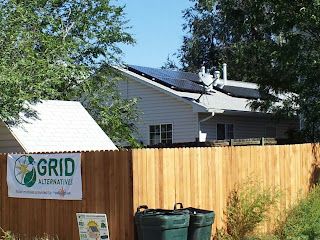OK, now that I’ve got your attention… you can’t possibly
have a heartbeat and not be aware of ongoing disputes concerning two important
energy sources: the expiring Production Tax Credit (PTC) for wind energy and
concerns over natural gas well hydraulic fracturing or fracking. Aside from the
fact that both of these issues have become highly politicized, what may be less
obvious to many folks is just how closely related these two issues really
are.
Wind energy proponents argue that without an extension of the
PTC (which presently provides a tax credit of $22 per MWh produced for the
first 10 years of a project’s life) new wind projects will come to a halt and
jobs will be lost. Hold that thought for
a moment but reserve judgment. On the
other hand, the fracking discussion is dominated by environmental concerns with
drilling and, in particular, how close drilling should be permitted to
residential communities. Back in June, I
penned a guest commentary in The Denver Post concerning the apparent inconsistency
in how these two energy sources were treated from a regulatory standpoint (click here for that column). To wit, the state appears totally
disinterested in the proximity of one type of industrial activity (wind) to
your back door while claiming primacy in regulating the other.
What is getting lost in this conversation is the fact that
the development of wind energy is dependent more on the price of natural gas
than on the PTC. When utilities, such as
Xcel, make the case for a new wind energy development, it is based on a
comparison to an equivalent amount of electrical generation from gas-fired
generators. While the PTC helps tilt
that comparison toward wind, low natural gas prices shift the balance back in favor
of gas generators. And, what is keeping
natural gas prices so low? The
development of previously unrecoverable shale gas resources using horizontal
drilling and, yes, fracking.
On the one hand stands a more than 20-year-old energy
industry (wind) that claims that it still needs a public subsidy “head start”
to compete, and on the other we have an even older energy resource that owes
its resurgence to technological advance.
Wind is among the least dense energy sources that we have, contributes
to energy sprawl covering thousands of acres, and typically produces the most
when demand is the least (i.e., the middle of the night). Natural gas generators, in contrast, are
relatively compact, flexible, and produce when demand is high. The drilling, however, leads to its own kind
of sprawl. Importantly, as evidenced in
recent Energy Information Agency reports, it is the increase in natural
gas-fired generation that is primarily responsible for recent reductions in CO2
emissions from electrical generation.
Jobs are at stake with both energy sources so that argument
is weak. At what point in time does wind
energy get weaned off the public subsidy – whether it be production tax credits
or higher ratepayer costs that result from the Renewable Energy Standard? Discussing the pros and cons of solar would
consume more electrons than can be allotted to this post, so I won’t even begin to
get into that, other than to say that there are both pros and cons there too. The Administration’s all-of-the-above
strategy is nonsense. What is needed is
an all-that-is-smart approach.
Environmental concerns with fracking are not totally
without merit. However, they emanate
more from poor well completions and near surface drilling contamination than from
what occurs deep underground. And, I
don’t believe that arguments calling for greater setbacks of drilling activity
from residential communities are misplaced either. Hence, Governor Hickenlooper’s recent suggestion
that additional changes to the oil and gas drilling rules may be in order is
well taken. On the wind energy side, it
is well past time that this industry got its costs in line so that it can
compete head to head with other energy sources.
Cutting off the PTC cold turkey may not be in the public interest, but phasing
it out over a few years may well be. Wind needs to focus more on real engineering
and less on financial engineering. Both
sources of energy will be important to the future development of sustainable clean
energy generation.
+at+Habitat,+29Sep2012.jpg)
